I hike several times a week, and I'm sharing the best hiking gear in my closet.
Our editors and experts handpick every product we feature. We may earn a commission from your purchases.Learn more.
I hike several times a week, and I'm sharing the best hiking gear in my closet.
Our editors and experts handpick every product we feature. We may earn a commission from your purchases.Learn more.
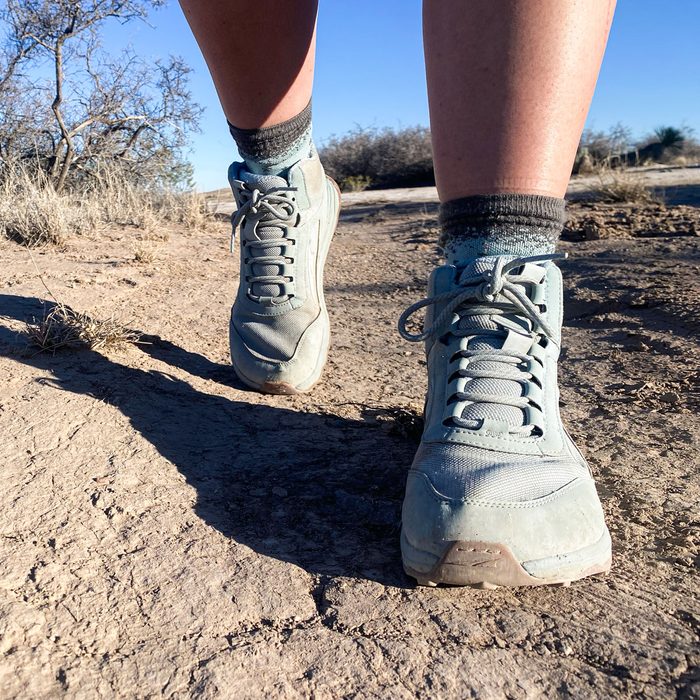 Amanda Capritto for Family Handyman
Amanda Capritto for Family Handyman
From the sandy scrub forests of South Florida to the desert terrain of New Mexico to the 14,000-foot peaks in Colorado, my Altra Lone Peak hiking boots have successfully taken me everywhere I’ve wanted to go—and I plan for them to continue taking me places until I bust a hole through the toe box. (Which, at more than 200 miles, hasn’t happened yet.)
The Altra Lone Peak hikers are wildly flexible, capable of moving with your foot through the entirety of each stride, from toe-off to foot strike. When I’m in my Altra hiking boots, it’s as if I can almost feel the earth beneath my feet; as if I’m hiking barefoot. This checks out, as the Altra Lone Peak hikers are zero-drop hiking boots with an ultra-wide footbed that allows for maximum toe splay.
As much as I love them, I must point out that they aren’t for everyone. If you’ve never worn zero-drop shoes before, it would be a bad idea to buy these and take them out for a hike right away. Individuals accustomed to more cushioned shoes with a substantial heel-to-toe drop should take their time adjusting to the zero-drop style to avoid pain and discomfort.
That said, if you’re anything like me, once you get used to these boots, you’ll never go back. They drain exceptionally well thanks to the breathable construction (I can’t speak for the waterproof version, because I don’t own them); the deep outsole lugs grip slippery terrain like shale and slate; and the extended heel clip provides extra stability with each foot strike.
As these boots are some of the best hiking gear, you can read more about the specifications, pros and cons of the Altra Lone Peak hikers in my full Altra Lone Peak hiking boot review.
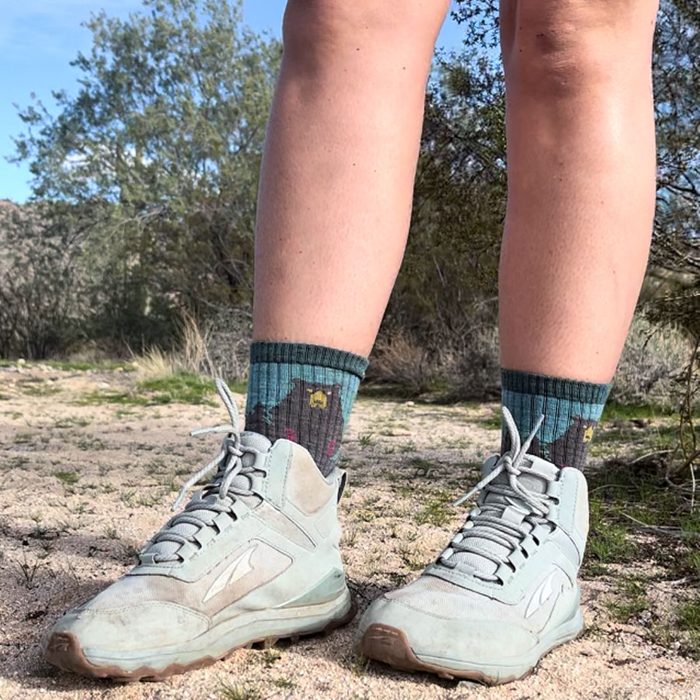 Amanda Capritto for Family Handyman
Amanda Capritto for Family Handyman
I thought Darn Tough was off its rocker for charging $25 and higher for socks until I slipped my feet into a pair of these magical, slipper-like, sweat-wicking, warmth-giving socks. Yes, they are all of the above and more, because they are made of mystical Merino wool, a fabric that makes me think wizardry must be real.
In temperatures ranging from 10 degrees to 100, Darn Tough socks have kept my feet not too cold, not too warm, but just right. I currently own three pairs of the Darn Tough Micro Crew socks and I’d own four if a dryer hadn’t eaten one. Sigh.
These socks are available in three weights (lightweight, midweight, and heavyweight) and two cushioning options (cushion and full cushion). I’m particularly fond of the midweight, full cushion option, especially for logging a lot of miles through various climates (for instance, starting in 60-degree weather at the trailhead and being met with 40-degree weather at the summit).
For the best hiking gear, I recommend the Micro Crew height, because they sit just above the collar on most hiking boots, preventing any rub from the boot. However, the hiking socks are also available in full crew, boot, quarter crew, and no-show options.
If, after reading all of these great things about Darn Tough socks, you’re still hesitant to spend nearly $30 on a pair of socks, you should know that they are backed by an unconditional lifetime warranty. If your Darn Tough socks rip, tear, or otherwise fail, you can send them back to Darn Tough and the company will send you a new pair free of charge. Darn Tough uses the returned socks to understand what went wrong and improve their products moving forward.
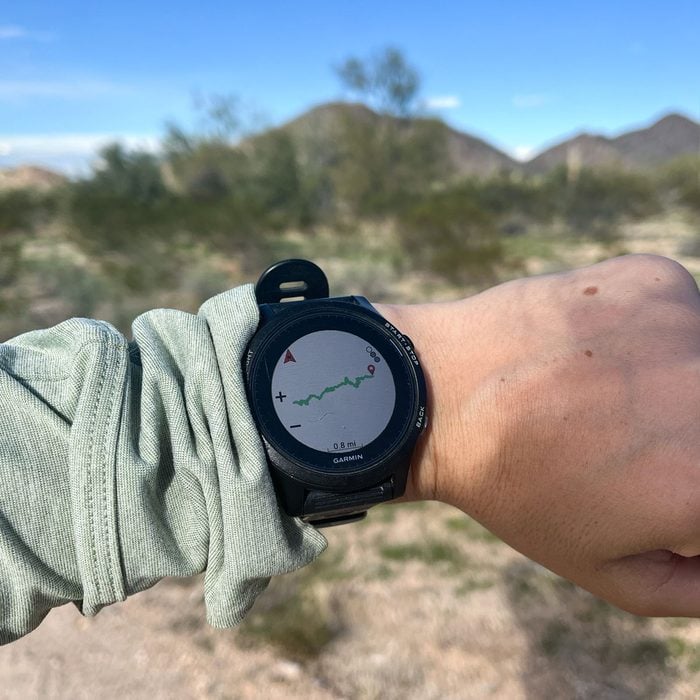 Amanda Capritto for Family Handyman
Amanda Capritto for Family Handyman
A GPS device is essential for hikers who hike solo, partake in cross-country (off-trail) hiking, hike to remote locations without cellular service or otherwise tend to find themselves in situations in which turn-by-turn directions might be required.
I recommend the Garmin Forerunner smartwatch series, which serves as both a highly capable fitness tracking device and a full-fledged GPS and mapping tool. I wear the Garmin Forerunner 935.
With the Garmin Forerunner 945/955/965, you can create routes with Garmin Courses or send routes to your Garmin watch via AllTrails once your AllTrails account is synced with your Garmin Connect account. When you download a route onto your watch, you can get turn-by-turn directions during your hike.
In addition to turn-by-turn directions, the Forerunner series also offers full-color mapping, round-trip routing, ClimbPro ascent planning and LiveTrack, a feature that allows you to share your real-time location with other people for safety.
What I love about this watch, though, is that it’s not just a hiking watch. If you participate in other active hobbies, including running, cycling, swimming, lifting weights, using cardio machines or doing HIIT workouts, the Garmin Forerunner smartwatch can track those, too.
Garmin does have “adventure watches” that are a bit more rugged and geared specifically toward hiking, but I think they may be a bit overkill for the average recreational hiker. We don’t all need enhanced topographic mapping, satellite imagery and access to the worldwide aeronautical database. (That’s just a smidge of what the $1,100 Garmin tactix 7 watch offers if you were wondering.)
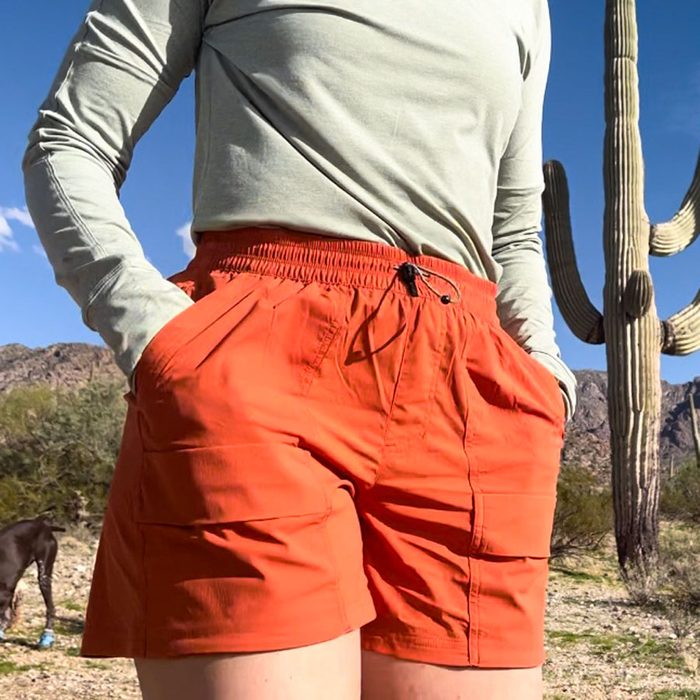 Amanda Capritto for Family Handyman
Amanda Capritto for Family Handyman
High-waisted? Check. Durable? Check. Long enough not to ride up and cause chafing, but still short enough to be flattering? Check. All of those attributes, and more, are what I love about the REI Co-op Trailmade hiking shorts.
The Trailmade shorts are some of the best hiking gear because they’re lightweight, made of 96% nylon and 4% spandex and they’re loaded with pockets. Seriously: There are six pockets on these shorts. The elastic waistband features a bungee adjustment system so you can get the fit just right. O me, a 5-foot-6 person with long legs and a short torso, the Trailmade shorts sit right at my belly button for a comfortable high-rise fit.
Great for summer hiking, the Bluesign-approved fabric has a UPF rating of 50+ (though you’ll still need sunscreen on the rest of your legs). The 5-inch inseam is a great length for hiking: short enough to keep you cool but long enough to prevent chafing at the widest part of the thigh.
The best part? These shorts are available for less than $50, which I know is still pricey for a pair of shorts, but it’s tough to find good hiking gear that will last—key phrase is “that will last”—for chump change. The Trailmade shorts are available in sizes extra-small to 3XL, in four colors.
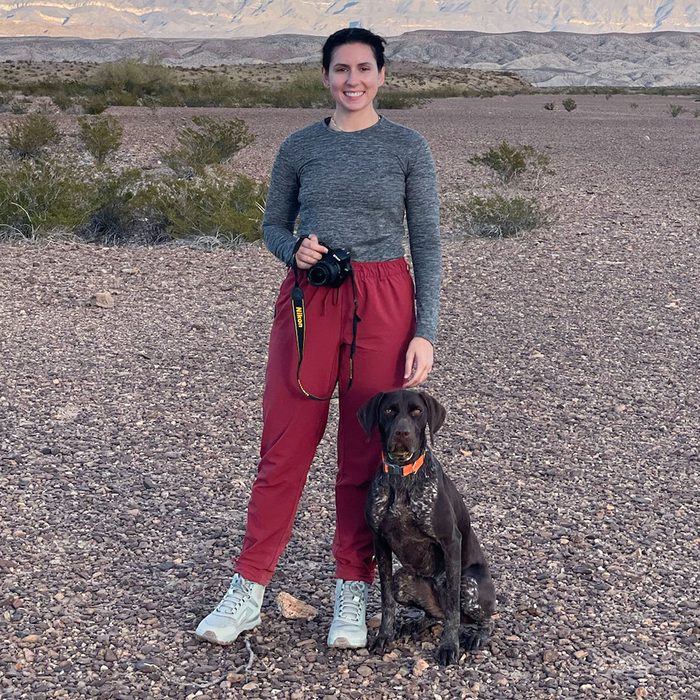 Amanda Capritto for Family Handyman
Amanda Capritto for Family Handyman
If you’re into hiking at all, and you haven’t seen the Coalatree Trailhead Pants on Instagram yet, I’d be very, very surprised. These hiking pants are all the rage and have been for months—and that shows in how hard they are to get. I was lucky enough to snag a pair in the beautiful Rust color, and I’ve been trying to get my hands on another pair (or three or four…) since the moment I finished my first hike.
Normally, I would try not to send my readers to a product that is often out of stock or available for pre-order only. But I would be wrong to lead you astray. Are there other excellent hiking pants available? Yes, there are, such as the REI Co-op Trailmade Pants, of which I own two pairs. But are there better hiking pants available? I truly don’t think so.
The Coalatree Trailhead Pants are 88% ripstop nylon and 12% spandex with four-way stretch, making them both highly abrasion-resistant (hello, bushwhacking) and spectacularly stretchy (hi, rock scrambling). They have deep pockets on each thigh that can fit an entire 16-ounce water bottle and a buttoned pocket on each hiney cheek. The antimicrobial fabric keeps sweaty smells at bay better than any other hiking pants I own, and it’s also water-repellent.
These pants are very breathable, making them the best hiking gear for warm weather. I recommend wearing a pair of leggings or long johns underneath them for winter hiking. I hiked to Guadalupe Peak (the highest point in Texas, located in Guadalupe National Monument) with a 6-degree trailhead start and 18-degree summit wearing the Trailhead Pants over a pair of Girlfriend Collective Compressive Leggings and my legs didn’t feel cold at all.
Additionally, the Coalatree pants are sized inclusively, without men’s or women’s labeling. They are simply available in sizes extra-small to 2XL and slim and regular fit. I fervently believe these are the best all-around hiking pants available today, with the only downside being that they are hard to get.
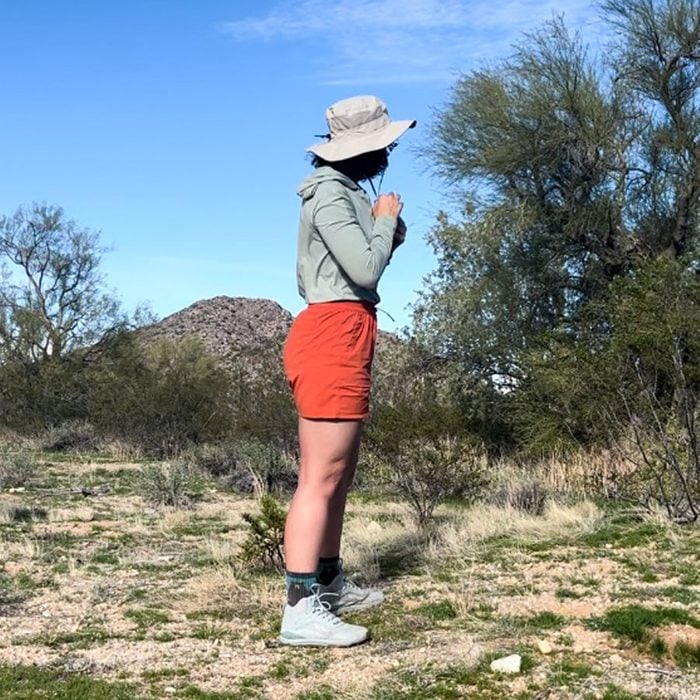 Amanda Capritto for Family Handyman
Amanda Capritto for Family Handyman
My Bora Bora Booney hat tags along with me for almost every hike, unless I know I’m going to be walking through a shaded canyon for most of the route. Even in winter, the sun can be brutal, and a wide-brimmed hat is key to protecting your face and neck simultaneously.
This Columbia hat is lightweight and adjustable, featuring mesh detailing for breathability and two adjustment points: the chinstrap and toggle at the back of the head. The sun is no match for its UPF 50 rating and 3-inch brim.
Made of 100% nylon, the Bora Bora Booney hat wicks sweat quickly, and the darker underside of the brim prevents sweat stains from showing prominently. For $30, this is a simple and easy way to protect your eyes, face, and neck from the sun while hiking.
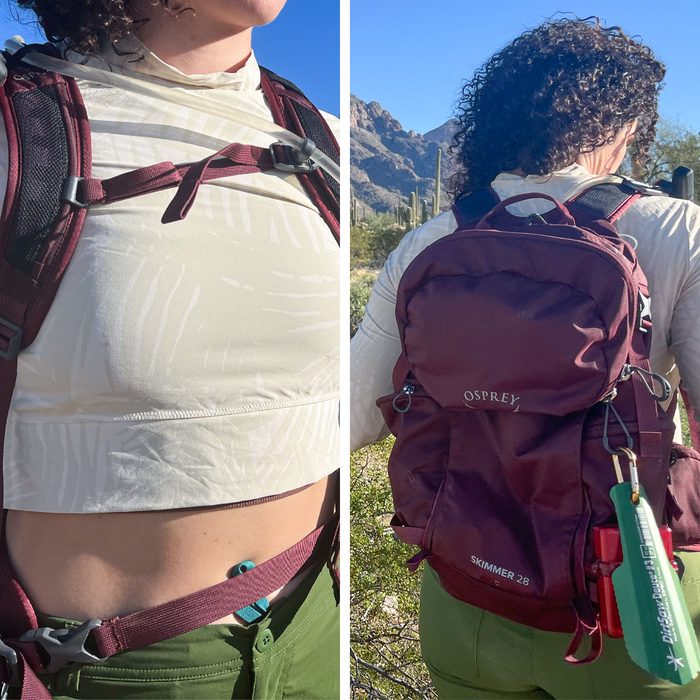 Amanda Capritto for Family Handyman
Amanda Capritto for Family Handyman
I splurged on the Osprey Skarab 30-liter hiking backpack when, after a could’ve-gone-really-wrong scenario on a solo hike in remote Utah, I realized that my then-current day pack didn’t have enough carrying capacity for long hikes in hot weather, especially if I was bringing my pup along.
After I miraculously got un-lost and recovered from a serious bout of dehydration, I went straight to the nearest REI and bought this pack: One that can carry 2.5 liters of water in a water bladder, with room for additional water bottles for my dog, and sufficient carrying capacity for ample food (human and dog).
The Osprey Skarab also has ample organizational components that make it easy to carry essential safety and wellness items. A satellite phone clips to the shoulder strap and there’s a bear spray holster. Sunscreen and insect repellent fit into side pockets. Lip balm, pain reliever, blister kit and an anti-venom device drop right into the two hip pockets. A mosquito net and emergency blanket fit in the front “shove-it” pocket.
This pack also has trekking pole attachment loops and an ice axe loop. It comes equipped with a 2.5-liter Hydrapak water bladder, with a dedicated sleeve and hydration tube port for easy sipping. The hydration bladder has a small magnet that connects to the integrated magnet on the pack’s chest strap, so the tube doesn’t fly around as you’re hiking.
The Skarab features a rucksack design with an open-mouth, top-load zip. This means the closure can be sort of annoying and floppy when the pack isn’t full, but it serves as a very voluminous lid when you’re stuffing it to the max.
All in all, after hiking with this pack for hundreds of miles, I’m pleased with my purchase. I recommend it to anyone looking for a high-capacity day pack. It’s overkill for short hikes, but I always prefer being over-prepared to the alternative.
 Amanda Capritto for Family Handyman
Amanda Capritto for Family Handyman
Planning to start your hikes before sunrise or watch the sunset at the summit? Then a headlamp is a top pick for the best hiking gear. I recommend the Petzl Tikka headlamp, which has been around for more than 20 years. I’ve had my Petzl Tikka since 2018 and it still works like a charm.
This simple but useful headlamp puts out up to 350 lumens, with three levels of white light and two red light (static and blinking) functions. It operates with just one button and features a tilting plate, so you can avoid blinding passers-by but still see the ground in front of you.
With a water-resistance rating of IPX4, the Petzl Tikka is not completely waterproof but can stand up to the rain you might encounter while hiking or camping. Don’t submerge it. The adjustable headband is soft and detachable, so you can remove the electronic portion and wash the band if it gets sweaty or dirty.
The Petzl Tikka functions on three AAA batteries, or you can purchase the compatible CORE rechargeable battery if you prefer a rechargeable option.
There are certainly some more robust headlamp options and an ultralight backpacker might scoff at the 94-gram weight of the Petzl Tikka. However, for most hikers, this simple and comfortable headlamp will more than suffice, and it costs less than $40.
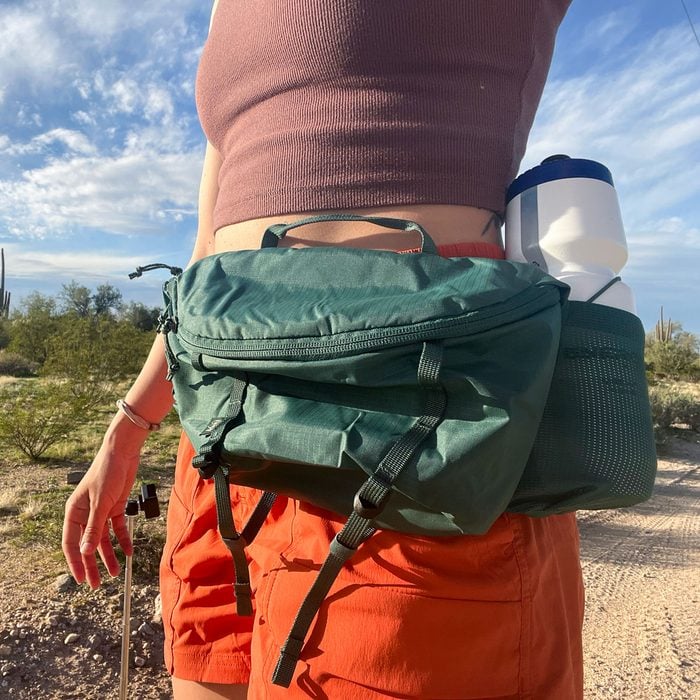 Amanda Capritto for Family Handyman
Amanda Capritto for Family Handyman
My newest obsession, the REI Co-op Trail 5 Waist Pack, is a large fanny pack with multiple pockets, including a water bottle pocket and a secret valuables pocket. It’s designed to be worn in the back, resting on your lumbar region, but I prefer to wear it in front, kind of off to one side, for easier access to my gear.
The 5-liter carrying capacity of this large waist pack accommodates my second camera lens, a 20-ounce water bottle, cell phone, headlamp, small first aid items, lip balm, small sunscreen stick, snacks, car keys and ID. It even has compression straps that allow you to minimize the size of the pack and/or clip on extra gear like a small towel.
Made of ripstop nylon, the Trail 5 Waist Pack is water-repellent and abrasion-resistant, yet lightweight at 9 ounces. It’s the best hiking gear for short hikes or for increasing your carrying capacity on longer excursions.
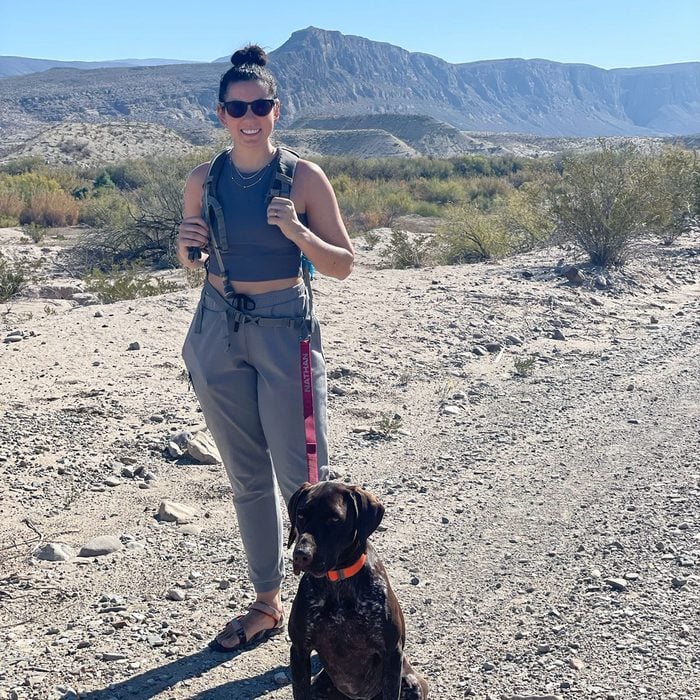 Amanda Capritto for Family Handyman
Amanda Capritto for Family Handyman
If you like to go hiking with your pup, a hands-free dog leash is a must. I picked up the Natahn Hands-Free Dog Leash with Runner’s Waistpack a year or so ago, and I use it every time I hike or walk with my dog. It clips to my fanny pack or backpack, with the clip on the opposite end attached to my dog’s collar.
I searched far and wide before deciding on this collar because I specifically wanted one shorter than the standard 6 feet. A 6-foot or even 4-foot leash attached at my waist is far too long and tangles up in my dog’s legs as she runs—and that doesn’t end well for anyone involved.
This leash is 3 feet in length and allows my dog enough leeway to adjust as needed, but doesn’t have so much slack it gets in the way. The included waist belt features a side-to-side glide for the leash, which is a nice touch. I typically just attach this leash to my usual hiking fanny pack or the waist strap on my backpack and find that it’s still long and adjustable enough thanks to the bungee design.
After more than a year of using the leash regularly, it’s still holding up perfectly and shows no signs of wear, other than the fact that the bright pink color is muted due to a few (or more) layers of dirt.
Heads up: This product includes a waist belt, not a waist pack, meaning it does not have carrying capacity. You can always clip the leash to a waist pack you already have, but if you need a waist pack, you’ll want to look elsewhere.
Safety and comfort are paramount during hiking adventures, even short excursions. It’s impossible to be over-prepared, but always possible to be under-prepared, especially if you are hiking alone. Here are a few things to consider for the best hiking gear.
For clothing, look for a relaxed fit with enough stretch to comfortably and freely move all of your limbs through a full range of motion. This means some inclusion of elastane (often as spandex or Lycra) is essential. Abrasion-resistant fabrics like nylon are ideal for pants and shorts, and durable water-repellent (DWR) treatment is a must for wet-weather hikes. For tops, I typically recommend something soft but breathable and moisture-wicking, such as a blend of merino wool and elastane.
For hiking boots, the ideal fit is flexible in the forefoot but secure around the heel and ankle. An extended crash pad is key for added stability, and depending on the conditions, you’ll want an upper that is either breathable and quick to drain (like knit mesh) or waterproof. Deep outsole lugs are necessary for slippery terrain. Heel-to-toe drop is preferential. A more minimal drop and low stack height allow you to feel what’s underfoot, but a higher drop with more cushion is more comfortable for many people.
When it comes to the best hiking gear packs—daypacks, backpacking packs, and waist packs—the most important thing is that the pack comfortably fits you and has the carrying capacity for what you need. It’s best to go in-store and try them on. You can always order online after finding one you like. If you hike a lot of trails with widely varying distances, as I do, you may end up with more than one pack to suit different excursions.
For electronics, such as GPS devices and satellite phones, ensure that the battery life is adequate for the types of adventures you plan to take. A watch that only lasts three hours in GPS mode, for instance, won’t be of much help on a six-hour hike. It’s always a good idea to carry a portable charger or small power bank, too.
I use every piece of gear that appears in this guide on a near-daily basis. I hike multiple times per week, with my excursions ranging from established trails and National Parks to (permitted) cross-country expeditions in wilderness areas. I’ve been hiking for years and have worn my way through multiple pairs of boots, pants and shorts. I’ve tried gear from dozens of brands and have learned lessons about proper hiking gear the hard way.
My hiking hobby began like most people’s: without any clue of what I was doing or how to prepare for it. Over nearly a decade, my love for this hobby has grown tremendously, and over time, I’ve invested in the best hiking gear to keep myself safe, comfortable and confident on the trail. Now, as a hiking- and outdoors-focused fitness coach, I even coach others to prepare for longer, tougher hikes, from beginners to advanced enthusiasts.
I recognize that gear preferences are highly preferential, but my top picks come from recognizable, reputable brands with a solid history of quality product production and strong warranties—because good hiking gear is designed to get beat up.
The best clothing for hiking depends entirely on the season and weather. For warm weather, loose-fitting, lightweight clothing with a UPF rating of at least 30 is ideal. For overgrown trails, wear long pants made of an abrasion-resistant fabric like nylon. Winter calls for warmer, heavier fabrics like wool and fleece. Rainwear is also essential. In all cases, some form of stretch is appreciated, so look for spandex, elastane or Lycra.
In my potentially controversial opinion, I think it’s hard to be over-prepared for a hike, especially when going solo. Even if you don’t end up needing everything you take, it is highly possible to encounter another hiker who didn’t bring enough water, food, sun protection, insect repellent or something else.
Even then, what to pack and what not to pack is a highly variable topic, considering different hike lengths and conditions call for different essentials. An ultralight hiker will have a different opinion about what’s essential for a given hike than someone willing to carry additional items for fun or comfort.
That being said, there are some things you don’t need to bring. For one, don’t bring any extra clothing that the forecast doesn’t call for. If you’re going hiking during the dry season in Arizona and there’s a 0% chance of rain, you don’t need to bring a rain shell “just in case.” If you’re not staying overnight, you don’t need a cot or a sleeping bag.
Check the detailed weather forecast, estimate the number of hours you’ll need to complete the hike, review the terrain and altitude changes, download the trail map and read reviews of the trail.
For a multi-day hike, you’ll need sturdy hiking boots, a large backpack, a sleeping bag, shelter (tent or hammock), layered clothing, cooking supplies, food, water filtration, navigation tools, a first-aid kit and safety gear like a personal locator beacon.
For a cold-weather day hike, pack moisture-wicking base layers, an insulated mid-layer, a waterproof outer layer, gloves, a hat, warm socks and sturdy boots. Don’t forget food, water, a headlamp, navigation tools and a small first-aid kit.